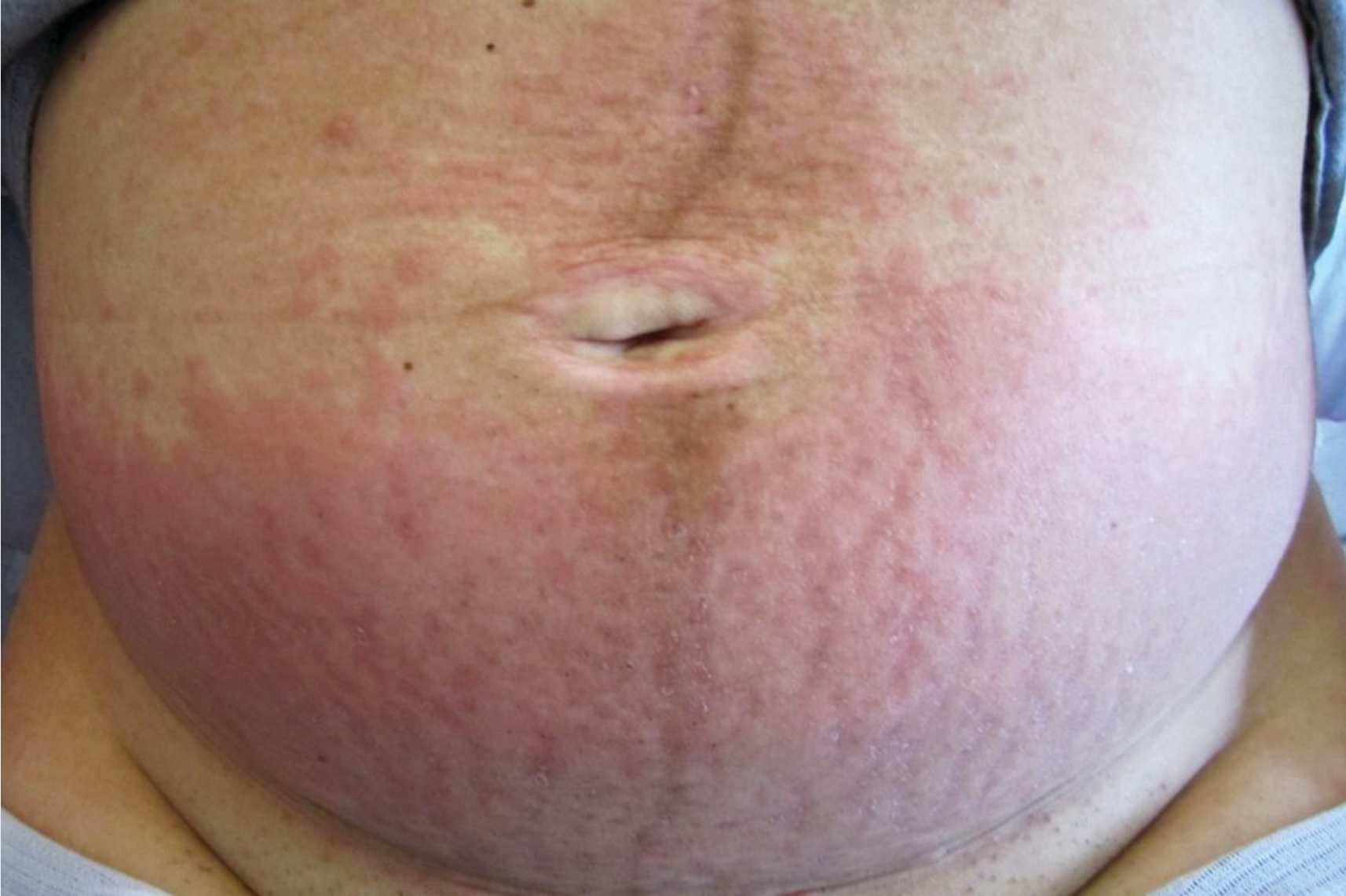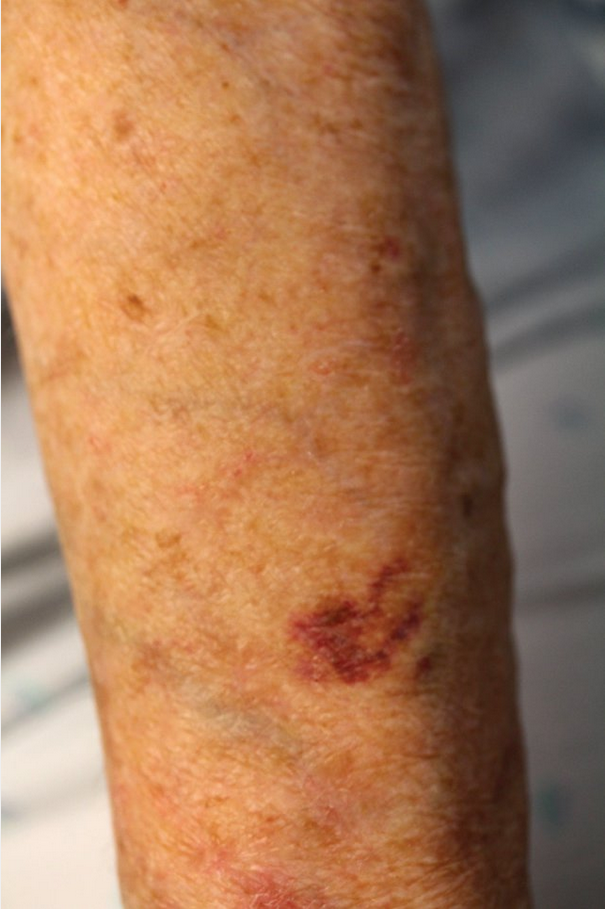Dermatologic Conditions of Pregnancy and Aging
- related: Dermatology
- tags: #dermatology
Pregnancy and Lactation
Women who are pregnant or lactating can present with unique skin findings, some of which are physiologic (Table 36) and others that may require treatment (Table 37). Preexisting skin conditions may be exacerbated during pregnancy or uniquely arise during pregnancy. Pruritic urticarial papules and plaques of pregnancy (PUPPP) is the most common specific dermatosis of pregnancy (Figure 160). Clinically, PUPPP appears late in the third trimester as erythematous plaques in the distribution of striae typically with sparing of the periumbilical skin. While the lesions may be restricted to abdominal striae, they may also appear on the arms and legs. Persistent and bothersome pruritus is a symptomatic hallmark of the condition. The condition usually resolves shortly after delivery. For symptom control, low- to medium-potency topical glucocorticoids are often first-line therapy; nonsedating antihistamines are sometimes required to control pruritus.
 Characteristic appearance of pruritic urticarial papules and plaques of pregnancy (PUPPP) in a gravid woman with edematous, erythematous plaques on the abdomen involving the striae. Note the relative sparing of the umbilicus.
Characteristic appearance of pruritic urticarial papules and plaques of pregnancy (PUPPP) in a gravid woman with edematous, erythematous plaques on the abdomen involving the striae. Note the relative sparing of the umbilicus.
Pemphigoid gestationis (herpes gestationis) is a pruritic blistering disease typically appearing during the second or third trimester. Urticarial plaques, papules, and vesicles first appear surrounding the umbilicus, but can involve the palms and soles. It usually spares the mucous membranes (Figure 161). A skin biopsy demonstrating a subepidermal bulla with neutrophils can confirm the diagnosis. Treatment with topical glucocorticoids is usually initiated for pruritus, and the lesions spontaneously remit following delivery. Pemphigoid gestationis is associated with an increased risk of fetal growth restriction and prematurity.
Treatment of dermatologic conditions during pregnancy can be challenging, as special consideration needs to be made for potential medication-induced teratogenicity. The FDA has published changes in pregnancy and lactation labeling for prescription drugs, effective June 30, 2015. The pregnancy letter categories will be removed with the new labeling requirements; however, for prescription drugs that were previously approved, these changes will be phased in gradually. This section will refer to previously approved drugs and their letter categories of risk (Table 38). It is important to consider these drugs when prescribing for women of childbearing age. For some drugs, there are regulatory programs to monitor medications such as iPledge for isotretinoin, STEPs for thalidomide, and mycophenolate REMS for mycophenolate mofetil.
Dermatologic surgery under local anesthesia (lidocaine) can be safely done during pregnancy if necessary; however, opiates and sedatives should be avoided in pregnant and lactating women.
Aging
Similar to other organs, the skin's functional capacity diminishes with age, thus increasing its susceptibility to cutaneous disorders such as dermatoses and skin cancer. Clinically and histologically, the skin structure changes (Table 39) from both intrinsic and extrinsic mechanisms (ultraviolet light, smoking). Nails can change as well. The nail growth rate begins to decline after the age of 25. Decreased lipophilic sterols and free fatty acids cause nails to develop some ridging and become more brittle. Generally, chest, axillary, and pubic hair all decrease with age. In men, there is increased hair in eyebrows, the nostrils, and external auditory meati. In women, the vellus hairs on the chin and upper lip convert into course terminal hairs possibly due to reduced estrogen levels. Hair graying can occur due to depletion of hair bulb melanocytes.
Dryness (xerosis cutis) is one of the most prevalent skin conditions in an aging population. While pilo-sebaceous glands become larger with age, there is a 50% reduction in sebum production. Excessive xerosis can cause xerotic dermatitis (eczema). It occurs more often in the winter (low humidity) and on the lower legs. It presents as dry fissured patches with a scalelike appearance (Figure 162). Severe xerosis can cause pruritus. Subsequent itching can result in actinic purpura. Good skin care measures are recommended, including the frequent application of emollients, especially immediately after bathing, to reduce dryness. Topical glucocorticoids can be applied to areas of inflamed skin.
Actinic purpura appears as purpuric macules or patches, most commonly on the forearms, due to minor trauma such as scratching (Figure 163). There may be associated stellate pseudoscars that are atrophic scars occurring after the skin tears. Actinic purpura is due to blood vessel fragility and dermal atrophy from aging. No additional testing needs to be done. There is no therapy for the purpura but sun protection is recommended to prevent further damage.

Infection
Group living arrangements such as skilled nursing facilities can predispose elderly persons to infestations with scabies, lice, or bedbugs (see Infestations). Herpes zoster and postherpetic neuralgia can occur more frequently in the elderly (see Common Skin Infections). Onychomycosis is more common in elderly populations (see Nail Disorders).
Chronic Wounds/Poor Wound Healing
Elderly persons with mobility impairments and comorbidities (cardiovascular disease, diabetes mellitus) are predisposed to chronic wounds such as venous, pressure, and diabetic foot ulcers (see Foot and Leg Ulcers).